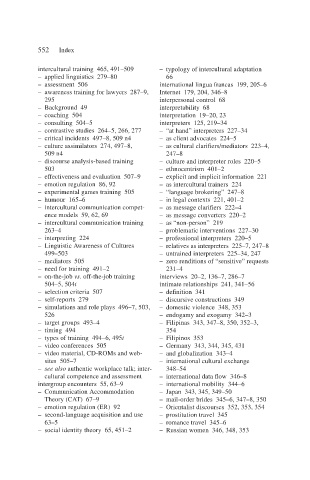Page 574 - Handbooks of Applied Linguistics Communication Competence Language and Communication Problems Practical Solutions
P. 574
552 Index
intercultural training 465, 491–509 – typology of intercultural adaptation
– applied linguistics 279–80 66
– assessment 506 international lingua francas 199, 205–6
– awareness training for lawyers 287–9, Internet 179, 204, 346–8
295 interpersonal control 68
– Background 49 interpretability 68
– coaching 504 interpretation 19–20, 23
– consulting 504–5 interpreters 125, 219–34
– contrastive studies 264–5, 266, 277 – “at hand” interpreters 227–34
– critical incidents 497–8, 509 n4 – as client advocates 224–5
– culture assimilators 274, 497–8, – as cultural clarifiers/mediators 223–4,
509 n4 247–8
– discourse analysis-based training – culture and interpreter roles 220–5
503 – ethnocentrism 401–2
– effectiveness and evaluation 507–9 – explicit and implicit information 221
– emotion regulation 86, 92 – as intercultural trainers 224
– experimental games training 505 – “language brokering” 247–8
– humour 165–6 – in legal contexts 221, 401–2
– intercultural communication compet- – as message clarifiers 222–4
ence models 59, 62, 69 – as message converters 220–2
– intercultural communication training – as “non-person” 219
263–4 – problematic interventions 227–30
– interpreting 224 – professional interpreters 220–5
– Linguistic Awareness of Cultures – relatives as interpreters 225–7, 247–8
499–503 – untrained interpreters 225–34, 247
– mediators 505 – zero renditions of “sensitive” requests
– need for training 491–2 231–4
– on-the-job vs. off-the-job training interviews 20–2, 136–7, 286–7
504–5, 504t intimate relationships 241, 341–56
– selection criteria 507 – definition 341
– self-reports 279 – discursive constructions 349
– simulations and role plays 496–7, 503, – domestic violence 348, 353
526 – endogamy and exogamy 342–3
– target groups 493–4 – Filipinas 343, 347–8, 350, 352–3,
– timing 494 354
– types of training 494–6, 495t – Filipinos 353
– video conferences 505 – Germany 343, 344, 345, 431
– video material, CD-ROMs and web- – and globalization 343–4
sites 505–7 – international cultural exchange
– see also authentic workplace talk; inter- 348–54
cultural competence and assessment – international data flow 346–8
intergroup encounters 55, 63–9 – international mobility 344–6
– Communication Accommodation – Japan 343, 345, 349–50
Theory (CAT) 67–9 – mail-order brides 345–6, 347–8, 350
– emotion regulation (ER) 92 – Orientalist discourses 352, 353, 354
– second-language acquisition and use – prostitution travel 345
63–5 – romance travel 345–6
– social identity theory 65, 451–2 – Russian women 346, 348, 353

